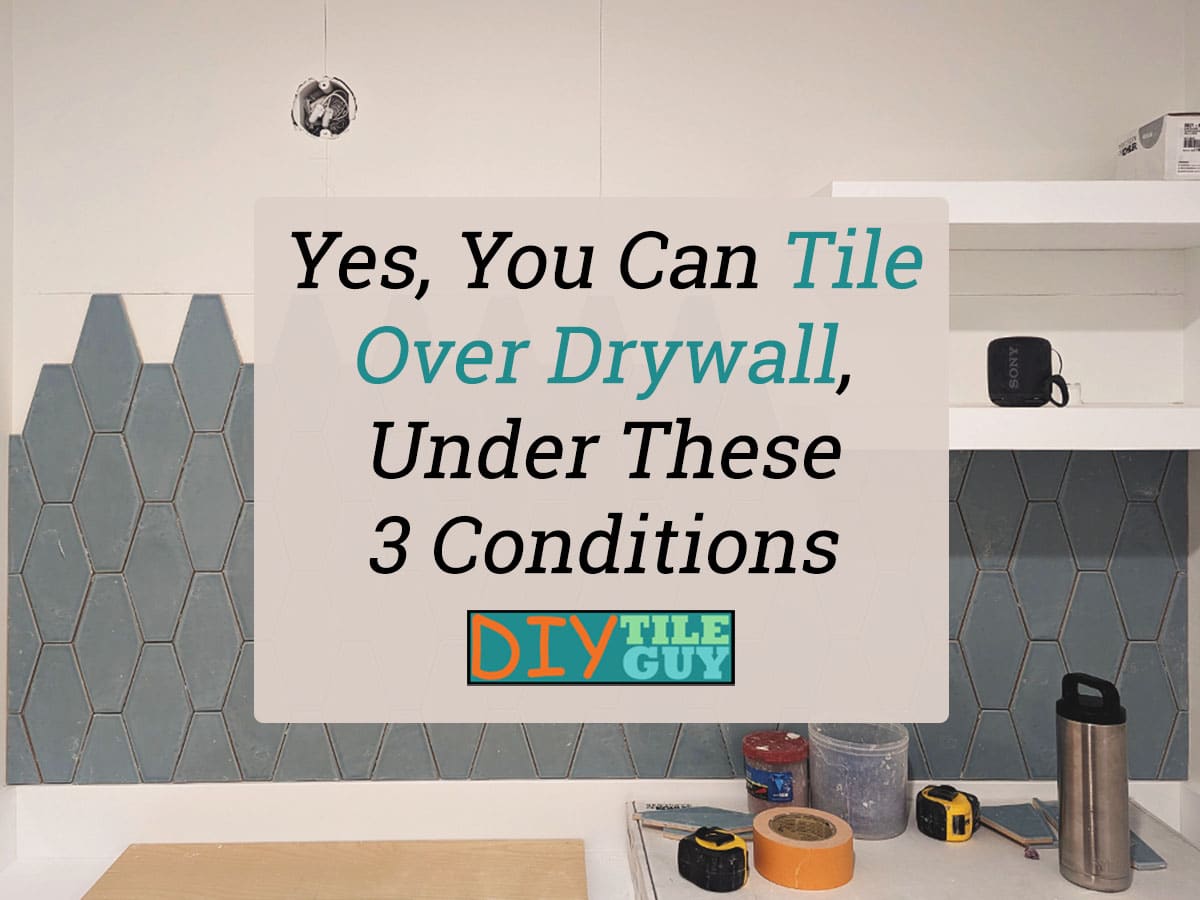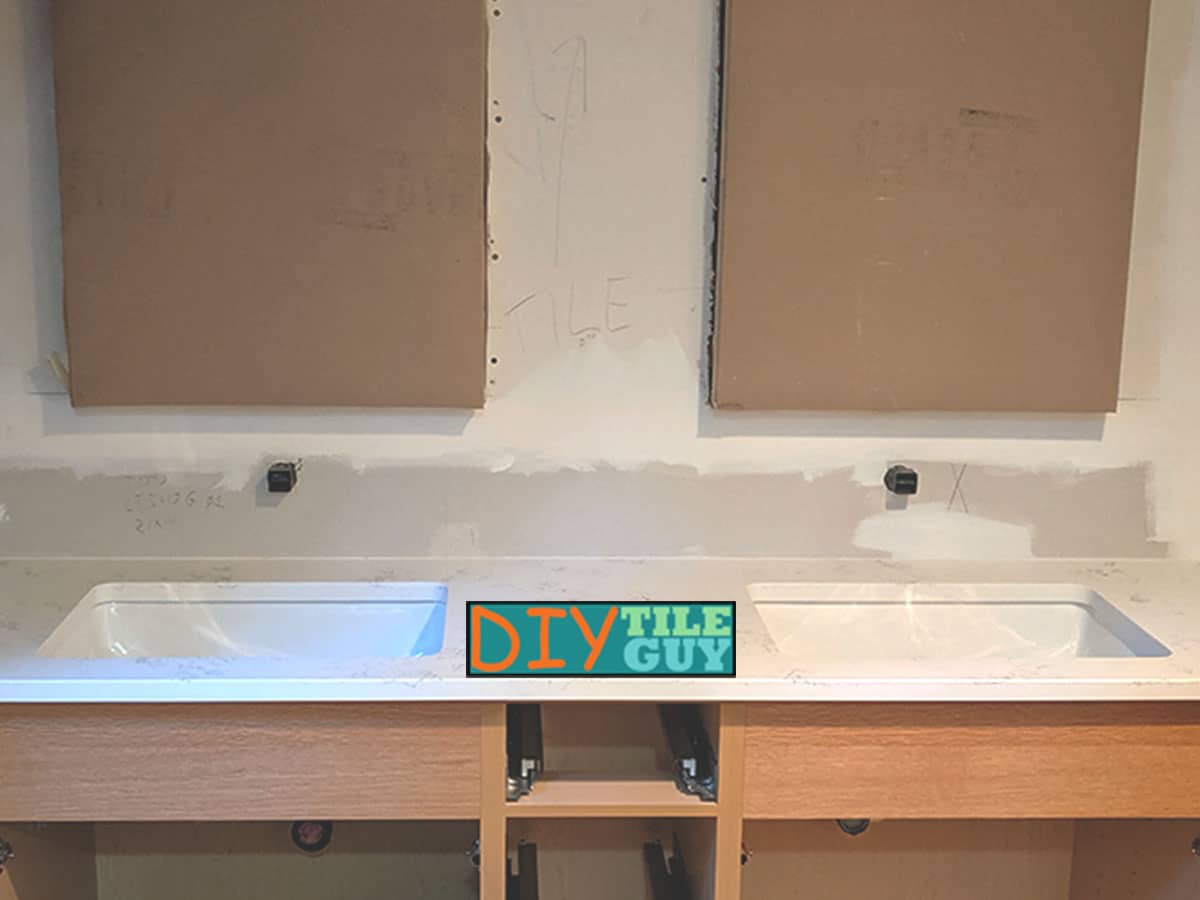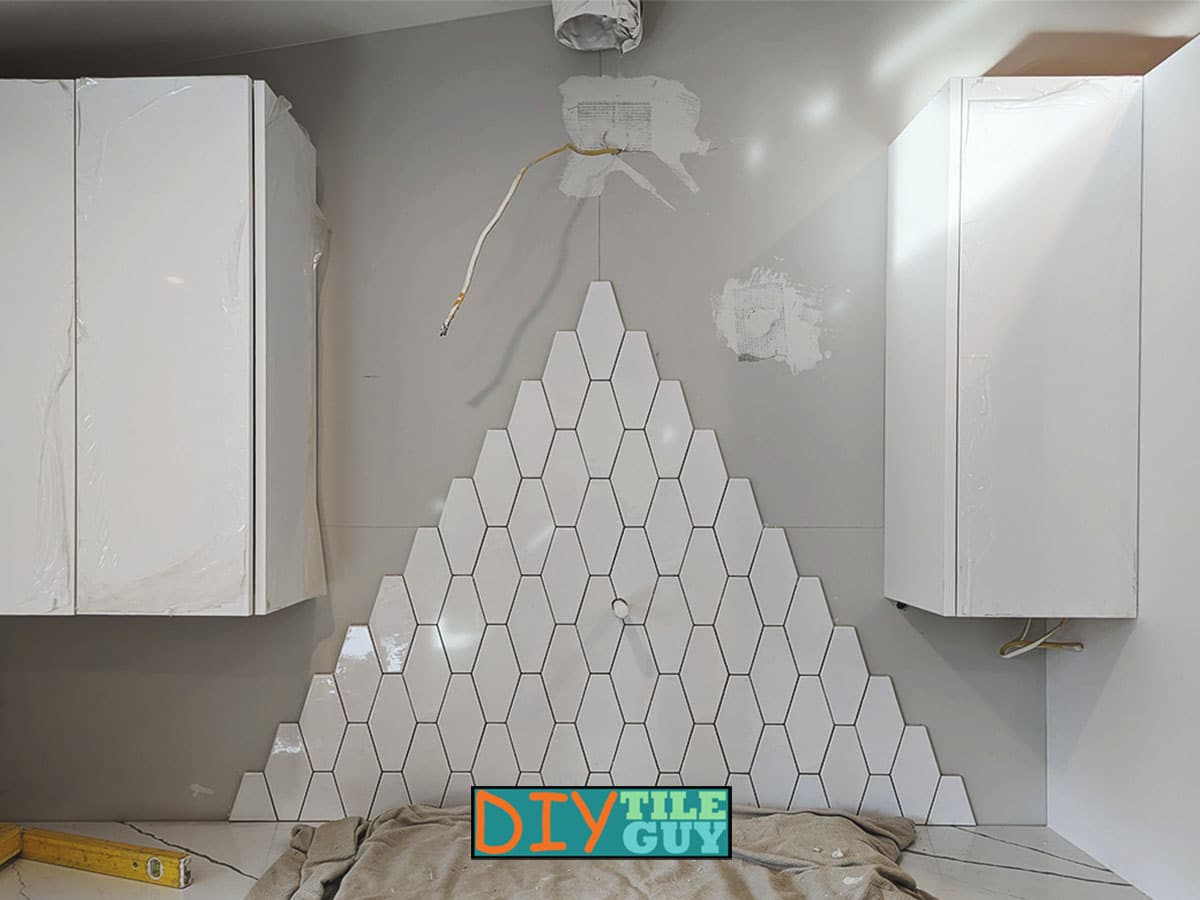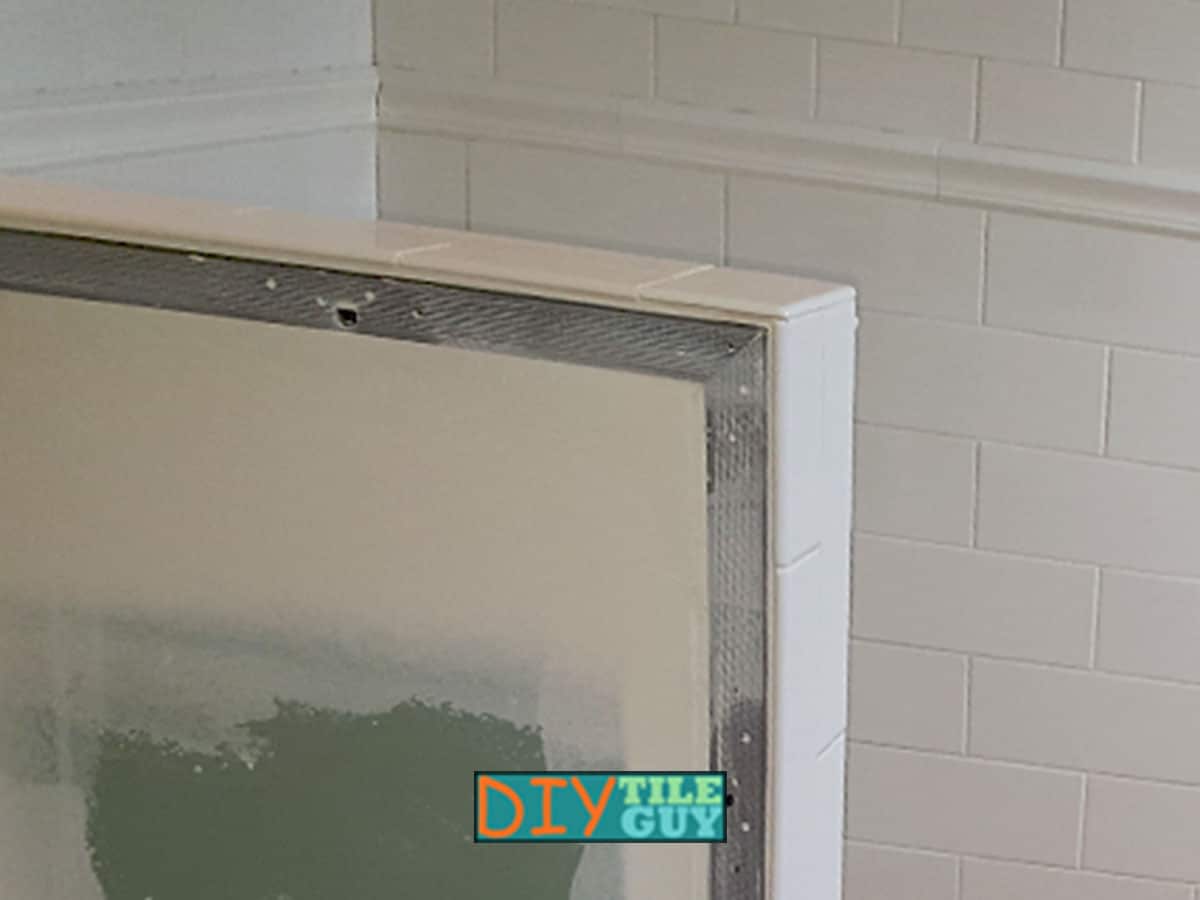With so many specialized tile backer boards and underlayment out there, it’s not crazy to wonder if it’s OK to tile directly over drywall. I’m here to tell you it is OK. As long as you follow these three rules:
- Tile is not in a wet area
- You are not tiling directly over drywall joint compound
- You make sure there are no bond breakers
If you can meet these three conditions, tiling over drywall is perfectly OK. Also, I’ve listed some best practices when tiling over drywall below.
Estimated reading time: 9 minutes

Let’s get into some of the details.
1. Don’t Tile over Drywall in a Wet Area
The first rule of tile over drywall is to make sure that this drywall isn’t installed in any wet areas. What is a wet area?
- Shower
- Bathtub surround with a shower head
- Swimming pool or fountain
So, if you are installing tile on your shower walls, then it’s not a good idea to have gypsum-based drywall installed over the walls.
The one exception to this is if you have the Kerdi Shower System installed over the drywall. I’ve discussed this before and Schluter is OK with installing their Kerdi membrane over a drywall surface.
However, if your tile installation is being installed directly over drywall, green board, or any other ‘moisture-resistant drywall’ then it had better not be installed in a wet area.
What if a backsplash is near a sink?
If you are installing a backsplash that is near a sink then this doesn’t count as a wet area in the world of tile. This means that it’s perfectly OK to install tile directly over the drywall’s surface.
Waterproofing drywall
I know what you are thinking: I’m going to go ahead and put that Red waterproofing stuff over the regular drywall just to make sure I do a good job!
However, if you do this you will limit the types of adhesives that you can use. Your best bet is to leave the drywall alone. It’s either OK to tile over the drywall or it isn’t.
If it isn’t, then you’ll have to use a proper tile backer like cement board.
Denshield
Glass mat tile backer boards like Denshield are OK to tile over. In fact, I’ve given my thoughts on these materials in my post on tile backer boards. Basically, they are OK to tile over even in wet areas.
But make sure that you know how to properly waterproof Denshield prior to installing different types of tiles over them.
Most people don’t read the instructions and have water damage later. Also, you limit the types of adhesive that you can use.
But, if you follow the instructions then you should be OK.

2. You’re not tiling over drywall joint compound
Condition #2 to tile over drywall is to make sure that you aren’t tiling over bare drywall mud.
If there is bare, drywall joint compound exposed then this will need to be primed with a latex primer before installing tile over it.
Can you tile over unpainted drywall?
Yes, it’s OK to tile over unpainted drywall as long as the seams do not have bare, drywall joint compound exposed.
It’s OK to tile directly over new, unpainted drywall. You don’t have to prime the whole surface, only over the drywall joint compound.
To show that this isn’t simply my opinion on the matter, Custom Building Products has a wall tile FAQ where they state “Bare gypsum drywall is a suitable substrate in all dry, interior applications.” [1]
Further, Schluter Systems doesn’t require the joints to be sealed before installing Kerdi Membrane over gypsum wall board.
“Schluter®-Systems does not require taping joints between drywall panels before installing Schluter®-KERDI/KERDI-DS” [3]
Drywall is already primed or painted
If your drywall surface already is painted then this would mean that the joints have been taped and filled with joint compound.
If all that you see is a normal wall with paint and texture then this is perfectly OK to tile over.
Joints are open with no tape or filler
This is the scenario that I prefer. Your drywall is fastened to the wall and the joints are open with no tape, no compound, and no primer painted over the drywall.
In this case, I will tape and ‘mud’ the joints with thinset mortar prior to installing any tile. Just like I would do if I were taping the seams of cement board.

3. Clean to remove contaminants or bond breakers
If you are simply tiling over an existing wall that is already painted then you’ll want to make sure that it’s clean and ready to accept tile.
For example, let’s say that you are tiling a kitchen backsplash that wasn’t tiled previously and was painted. In this case, you’ll want to make sure there is no grease or contaminants on the surface that will interfere with getting a good bond.
Additionally, lightly sanding the surface of the paint will help increase the ability of the tile to get a strong bond.
Tile Over Drywall- Best Practices
We’ve gone over a lot of what-not-to-do. Now let’s go over what-TO-do when installing tile over drywall.
Well fastened
You want to make sure that the drywall panels are well-fastened. It’s not unusual to find sections of wall panels that are loose and missing screws.
How many fasteners for tiling over drywall?
According to USG, they want screws fastened a maximum of 16 inches apart for walls. To me, that’s not very frequent but that’s what they require. Note: nails are 8-inch maximum spacing for walls. [2]
Further, there are no real negatives to adding a few more fasteners than the minimum required as long as the screws don’t penetrate pipes or electrical wires.

Drywall is flat and smooth
You want your drywall to be flat and have a smooth surface. This doesn’t mean that it can’t be textured or that it has to be perfectly smooth.
Rather, you want to make sure that your drywall patches are flush and even with the rest of the wall. You don’t want a bunch of patching which can lead to an uneven surface if you can help it.
How flat should your walls be before tiling over drywall?
For best results, you want your walls to be flat before installing new tile. The tile industry standards are as follows:
- Tile less than 15 inches long: Walls should have no more variation than 1/4 inch in 10 feet and 1/16th in 12 inches
- Tile with one or more edges 15 inches or longer: Walls should have no more variation than 1/8 inch in 10 feet and 1/16th in 24 inches
I think you’ll find that these are pretty tight tolerances but do help to produce great-looking tile walls.
Your best bet is to flatten the walls before putting up your new drywall. If this isn’t possible then the preferred method is to use a flattening compound as found in this post: [link to underlayment post]
Sealed and primed
As previously mentioned, you want any exposed drywall joint compound to have primer painted over it.
Additionally, this goes for any spots where the paper facing may have been removed and the gypsum is exposed underneath.
Otherwise, any open joints that will be covered with tile can be filled with thinset mortar and covered with mesh tape prior to installing any tile.
Use the proper tile adhesive
Mastic
Premixed tile mastic can be used in some situations. However, if your tile is too big or is glass then you’ll want to use a proper thinset mortar.
Thin-set mortar
This is your best option when installing any tile. You still need to make sure that you get the right mortar for the right tile.
This post talks about which thinset is best for wall tile.

Tiling over Drywall: Outside Corners
A typical outside drywall corner has a metal piece that you’ll find tends to stick out and isn’t flat with the rest of the wall.
You may not notice this when it’s just painted but you’re going to notice it when you try to tile over it.
Here are two ways to handle the outside corner of a wall when installing tile:
When tile is only going on one side of the corner
If you are only installing tile on one side of the corner and the other side will be painted then the best way to handle it is to flatten the tile side of the wall to the corner as best that you can.
See above where I talk about flattening the walls.
When tile is covering both sides of the corner
When you will be installing tile on both sides of the corner then the best way to flatten the corner out is to remove it. Otherwise the corner is there just to interfere with the flatness of the walls.
Go ahead and remove the metal outside corner and install some 4-inch mesh tape over both sides of the corner and fill with thinset mortar.
Then you can wrap the corner without interference from the drywall corner. Obviously, the exposed edge of your tile will need a tile trim piece.
A lot of tiles over drywall involves Kitchen backsplashes
Most of your tiling over drywall is going to be projects like a ceramic tile backsplash, wainscot walls, and fireplaces.
Otherwise, it seems like most of the wall tiling is in wet areas where you will have a different substrate like cement backer board, as an example.
Finally, this post covers how to calculate the square footage that you will need for tile. You may find it useful as a next step.
Is there anything that I’ve left out? Ask your questions in the comments below.
References
- Custom Building Products Wall Installation FAQ pdf
- USG Sheetrock Brand Installation and Finishing Guide pdf
- Schluter Shower System Installation Handbook; Installation Walls & Ceilings; Schluter -Kerdi over solid backing
Leave a Reply